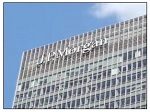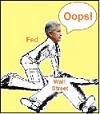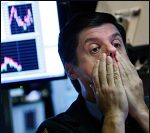-
Recent Posts
- It’s Time to Name the “Wall Street Financiers” in the Epstein Files
- Trump’s “Big Beautiful Bill” Is a Grotesque Giveaway to Fossil Fuel Billionaires While Adding $3.3 Trillion to Nation’s Debt
- Senator Chris Murphy Charges that Trump “Has Opened a Channel for Bribery”
- Congressman Casten: Trump’s Assault on the Rule of Law Is Causing Capital Flight Out of U.S. by Foreign Investors
- Trump’s Approval Rating Drops to 80-Year Low; IMF Says U.S. Tariffs Now Exceed the Highs During the Great Depression
- Nasdaq Has Lost More than 3,000 Points Since Trump’s First Full Day in Office in 2025; the Pain Has Barely Begun
- The Bond Crisis Last Week Was a Global No-Confidence Vote in U. S. President Donald Trump
- Trump’s Tariff Plan Guts $5 Trillion in Stock Value in Two Days; Senator Warren Calls for Emergency Action Before Markets Open on Monday
- Trump’s Attacks on Big Law, Universities, and the Media Have a Common Goal: Silence Dissent Against Authoritarian Rule
- Trump Administration Gives All Clear to Laundering Money through Shell Companies and Bribing Foreign Officials
- Four Megabanks on Wall Street Hold $3.2 Trillion in Uninsured Deposits – Which May Explain Senator Schumer’s Pivot to the GOP to Stop a Government Shutdown
- Here’s What Came Crashing Down Yesterday for Trump’s “Genius” Guy, Elon Musk: Tesla Stock, Access to Twitter (X), His Years of Secret Calls with Putin
- After Banning the Associated Press, Trump Is Now Targeting Specific Journalists That He Wants to See Fired
- Closely Watched Atlanta Fed Model Predicts Negative U.S. Growth in First Quarter
- Trump’s Gangster Diplomacy Makes Front Page Headlines Around the Globe
- Who Benefits Alongside Elon Musk If He Succeeds in Killing the CFPB: the Megabanks on Wall Street that Underwrite His Tesla Stock Offerings
- In Trump 1.0, the State Department Used Taxpayer Money to Publish a Book Elevating Elon Musk to a Superhero; It Was Funded by USAID, the Agency Musk Wants to Quickly Shut Down
- News Host Joy Reid Raises Threat of Trump Selling U.S. to Putin; Ten Days Later Her Show Is Cancelled
- Elon Musk’s DOGE Appears to Be Violating a Court Order; It Has Taken Down Hundreds of YouTube Videos that Educate Americans on How to Avoid Being Swindled
- Barron’s Releases Audio of Jamie Dimon Cursing Out His Workers at a Town Hall, as Dimon Plans to Dump Another One Million JPM Shares
- There’s One Federal Investigative Agency that Neither Trump nor Elon Musk Can Touch: It Just Opened an Investigation into DOGE
- Elon Musk’s Companies Were Under Investigation by Five Inspectors General When the Trump Administration Fired Them and Made Musk the Investigator
- Donald Trump Gives the Greenlight to Goldman Sachs and JPMorgan Chase to Return to Bribing Foreign Officials
- After Tech Geeks Built a Back Door to Loot Billions from FTX, Republicans Refuse to Investigate What Elon Musk’s Tech-Squad Did Inside the U.S. Treasury’s Payment System
- Former Prosecutor, Now U.S. Senator, Informs Tesla That CEO Musk May Be Violating Federal Law and to “Preserve All Records”
- Trump’s Hedge Fund Guy Is Now Overseeing the U.S. Treasury, IRS, OCC, U.S. Mint, FinCEN, F-SOC, and the Consumer Financial Protection Bureau
- As Elon Musk Begins Shutting Down Payments to Federal Contractors, a Strange Money Trail Emerges to His Operatives Inside the U.S. Treasury’s Payment System
- JPMorgan Chase Charged by Yet Another Internal Whistleblower with Cooking the Books
- We Asked Google’s AI Search Model, Gemini, Questions About the Fed and Wall Street Megabanks: It Got the Answers Dead Wrong
- With Trump and Melania’s Crypto Coins Likely to Raise Legal Challenges, Why Didn’t Trump Fire the SEC’s Inspector General in His Purge of IGs?
- Fossil Fuel Industry Could End Up Paying Tens of Billions for LA Wildfires and Deceiving the Public on Climate Change for Decades
- It’s Being Called the Biggest Grift by a President in U.S. History: Trump and First Lady Launch their Own Crypto Coins
- Trump Plans to Install a Fracking CEO to Head the Energy Department and Declare a National Emergency on Energy to Gain Vast Powers
- Fossil Fuel Money Played a Role in the Los Angeles Fires and the Push to Install Pete Hegseth as Secretary of Defense
- When It Comes to Wealth Retention in Retirement, Concrete May Be the New Gold
- Wall Street Watchdog Warns “Clock Is Ticking on a Coming Catastrophic Financial Crash”
- Wall Street Is Sending the Same Message to Americans on Fossil Fuel Financing that It Sent on Cigarettes: Drop Dead
- In a Six-Week Span, this Dark Pool with a Curious Past Traded 3.7 Billion Shares
- Wall Street’s Lobby Firm Hired Eugene Scalia of Gibson Dunn to Sue the Fed for Jamie Dimon
- Postmaster General Louis DeJoy Made $561,051 in Compensation in 2024, as Mail Costs Spiked and Delivery Deteriorated
- Fed Chair Jay Powell Sends a Bold Message to Trump and Tanks the Dow by 1123 Points
- The Head of Fixed Income at T. Rowe Price Makes the Scary Case for the 10-Year Treasury to Spike to 6 Percent
- $663 Billion in Cash Assets Have Gone Poof at the Largest U.S. Banks
- Donald Trump to Ring Bell at New York Stock Exchange Today as Hit List Posters Appear in Manhattan Targeting Wall Street CEOs
- Trump Has a Slush Fund to Prop Up the Dollar – Will He Use It to Prop Up Bitcoin Instead?
- A CEO Assassination; a Billionaire Heiress/NYPD Commissioner; a Secret Wall Street Spy Center – Here’s How They’re Connected
- Despite More than 1600 Tech Scientists Signing a Letter Calling Crypto a Sham, Trump Names a Crypto Cheerleader for SEC Chair
- The Fed Rings a Warning Bell: Hedge Funds and Life Insurers Are Reporting Historic Leverage
- Trump’s Nominee for FBI Director, Kash Patel, Has Businesses Financially Intertwined with Trump
- Donald Trump Is at Risk of Getting Named in a Fossil Fuels Conspiracy Lawsuit
Category Archives: Uncategorized
JPMorgan Chase’s Derivatives Spike by $14 Trillion in First Quarter to Six-Year High of $60 Trillion

By Pam Martens and Russ Martens: June 24, 2022 ~ Add JPMorgan Chase, the biggest bank in the United States with an unprecedented five criminal felony counts since 2014, to the growing list of debacles of which the Fed has lost control. The Fed has its bank examiners pouring over the books of JPMorgan Chase on an ongoing basis, but somehow the bank’s dangerous book of derivatives has been allowed to spike by $14.42 trillion in the first quarter of this year, soaring from $45.84 trillion on December 31, 2021 to $60.26 trillion on March 31, 2022. That’s an increase of 24 percent in a three-month span. That information comes from page 18 of the newly-released report on derivatives in the banking system from the Office of the Comptroller of the Currency (OCC). The Dodd-Frank Act of 2010 was supposed to stop the insanity of unfathomable amounts of risky derivatives being … Continue reading
Is the Crypto Threat to U.S. Financial Stability $889 Billion or $10 Trillion?

By Pam Martens and Russ Martens: June 23, 2022 ~ Yesterday, Benzinga reported on a curious statement made by Fed Chair Jerome Powell during his appearance before the Senate Banking Committee on Wednesday. Powell was asked by Senator Kyrsten Sinema (D-AZ) if the Fed had been tracking the events in the crypto markets in the past several weeks. Powell responded that the Fed was watching those events “very carefully” but the Fed “did not see significant macro-economic implications.” The article goes on to lend credence to this observation from the Fed by noting the following: “It is important to note the entire cryptocurrency market cap is $889.25 billion versus the American GDP, which is $25.34 trillion, and an equities market that controls more than $49 trillion.” Before we drill down into the weeds of that crypto market cap figure, it’s important to note that former Fed Chair Alan Greenspan told Congress that he saw no major … Continue reading
Crypto Victims’ Cries for Help Are Piling Up at a Federal Complaint Center

By Pam Martens and Russ Martens: June 22, 2022 ~ The Consumer Financial Protection Bureau (CFPB) is the federal agency that was created under the Dodd-Frank Act of 2010 in response to Wall Street’s harrowing abuses to average Americans in the leadup to the financial crash of 2008. One of its key benefits is that it has a complaint database where consumers can post their complaints to the agency, and the general public and reporters can read those complaints on a public website. The general public benefits by seeing what types of complaints are being made against a financial institution they might be considering doing business with and reporters can look for dangerous patterns that are emerging. We delved into a specific area of complaints at the CFPB yesterday. We put the word “Bitcoin” into the search box and pulled up 1,031 matches. Next we searched under the word “crypto” and … Continue reading
Has Crypto Endangered Federally-Insured Big Banks? Ask State Street

By Pam Martens and Russ Martens: June 21, 2022 ~ There have been a number of articles lately attempting to reassure Americans that the crypto carnage will not cause financial instability or an economic collapse in the U.S. like that of 2008. The fact is, absolutely no one can say with any degree of certainty what will be the outcome of this unprecedented era of reckless investing. That’s because anything that causes the megabanks on Wall Street to pull back from lending to one another or to major counterparties – out of fear that the institution has dangerous crypto exposure – could cause the same contagion effect that occurred in 2008 from opaque derivatives and toxic subprime debt exposures. We decided to have a look at the websites and quarterly SEC filings (10-Qs) made by the megabanks on Wall Street, the ones that since the repeal of the Glass-Steagall Act in … Continue reading
After Crypto Money Piled into Campaign Coffers of Senators Lummis and Gillibrand, They Introduced a Sweetheart Legislative Bill for Crypto

By Pam Martens and Russ Martens: June 20 , 2022 ~ On June 7, Senator Kirsten Gillibrand, a Democrat from New York who sits on the Senate Agriculture Committee which oversees commodities, and Senator Cynthia Lummis, a Republican from Wyoming who sits on the Senate Banking Committee which oversees Wall Street and trading, introduced a bill as an early Christmas present to the crypto industry. It carries the Alice in Wonderland title of the Responsible Financial Innovation Act. In reality, it is an irresponsible piece of legislation whose sponsorship by these two women only makes sense when you understand that their campaign coffers are being stuffed with money from the crypto industry. Let’s start with Lummis. A $5800 donation is not a big deal to every member of Congress. But it is a big deal to a Senator from Wyoming, a state whose population is less than 600,000. According to data … Continue reading
As the Speeding Crypto Train Crashes, Scientific and Engineering Experts Tell Congress that Both Crypto and Blockchain Were a Sham from the Beginning

By Pam Martens and Russ Martens: June 17, 2022 ~ Crypto pushers hired themselves Trump’s outgoing SEC Chairman, Jay Clayton; a boatload of celebrities like Matt Damon (see his commercial below), LeBron James, Spike Lee, Tom Brady, Alec Baldwin, among numerous others; and high-priced lobbyists to sway Congress and state legislatures to back off any regulatory push. Crypto even slapped its name on sports stadiums and arenas – similar to Enron and Citigroup just before they blew up from specious business models. Like any other pump and dump scheme, crypto mania worked for a while. Insiders grabbed their windfall profits early and left the unsophisticated with the losses. Now crypto concerns are hiring themselves the likes of Big Law firm Akin Gump to explain why investors can’t get access to $11 billion in frozen accounts at Celsius Network. The warnings have been out there for years now from experts in the … Continue reading
The Fed Fingers Its Worry Beads: Mortgage Rates Double in Six Months to 6.28 Percent; Crypto Crashes; Layoffs Explode in FinTech

By Pam Martens and Russ Martens: June 15, 2022 ~ Wall Street does not have exclusivity on the pain trade. There’s pain at the pump for average Americans, pain at the grocery store, and now, adding to the pain for American home buyers who have watched the cost of homes spiral upward over the past year, the national average on the 30-year fixed rate mortgage just spiked to 6.28 percent as of yesterday. Mortgage News Daily reported the following yesterday: “The average lender is quoting top tier 30yr fixed rates in the 6.25-6.375% range, but as we discussed yesterday, it’s cheaper than normal to buy one’s rate down. That means rates in the high 5’s are still being quoted, but those quotes imply higher upfront costs (aka ‘points’).” Interest rates on the 5-year and 10-year U.S. Treasury notes are also rising at a breathtaking pace – effectively doing much of the … Continue reading
Crypto-Carnage Hits Every Asset Class Tied to Crypto

By Pam Martens and Russ Martens: June 14, 2022 ~ It wasn’t just cryptocurrencies that crashed yesterday, it was crypto exchanges, crypto mining stocks, publicly-traded companies holding large investments in crypto, and crypto ETFs. By the time the closing bell rang yesterday, ProShares Bitcoin Strategy ETF had tanked by 20.22 percent on the day, bringing its year-to-date loss to 50.4 percent. Other crypto-related ETFs were similarly hammered. VanEck Bitcoin Strategy ETF gave up 19.86 percent, bringing its year-to-date loss to 53 percent. Shares of crypto mining stocks, which were already battered and bruised, were further bloodied. Among the worst of the lot was BIT Mining Ltd. (ticker BTCM) which plunged 36.60 percent yesterday, bringing its year-to-date loss to 79.9 percent. The graphic below shows how nine other crypto mining stocks performed yesterday. Year-to-date, these stocks have lost 60 to 85 percent of their market value. The companies are: Argo Blockchain PLC … Continue reading
Five U.S. Megabanks Have Lost $300 Billion in Market Cap in One Year; Crypto Is in Meltdown this Morning; and the Fed Will Hike Rates Further on Wednesday

By Pam Martens and Russ Martens: June 13, 2022 ~ Welcome to Monday morning and market hell. As of 8:47 a.m. (ET) this morning, Dow futures are down 553 points; Bitcoin futures have lost 17 percent of their value on the news that cryptocurrency lender, Celsius Network, has frozen withdrawals. The 5-year Treasury note has spiked to yield 3.38 percent, a 50-basis point increase in a month, leading to an inverted yield curve against the 10-year Treasury note, which is trading at 9:01 a.m. (ET) this morning at a yield of 3.27 percent. (An inversion signals a rising recession risk.) All of this comes as the Fed has signaled that it will announce another interest rate hike this Wednesday, following the two-day meeting of its Federal Open Market Committee (FOMC). Stocks are developing a habit of tanking one day after Fed Chair Jerome Powell holds his FOMC Wednesday afternoon press conference, … Continue reading
The Money Trail to the January 6 Attack on the Capitol Is Ignored in Last Night’s Public Hearing

By Pam Martens and Russ Martens: June 10, 2022 ~ As we watched the two-hour public hearing on the critical facts uncovered by the House Select Committee on the attack on the U.S. Capitol on January 6, 2021, we kept waiting to hear a discussion of the money trail that facilitated this attack. That discussion never came. And yet, big expenses were involved: dozens of buses were rented; signs advertising “Stop the Steal” were on the sides of some of those buses; food and lodging had to be paid for, in or around expensive Washington, D.C.; and, now, lawyers have to be paid to represent those indicted for brutalizing police on January 6 or destroying and/or stealing government property. The House Select Committee did an excellent job last evening of providing the big picture on the plot to shred U.S. democracy in service to Donald Trump’s megalomaniac desires. But the question … Continue reading

